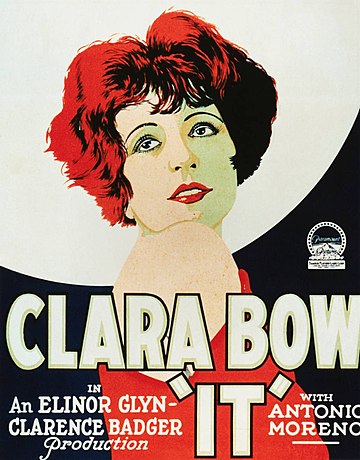An "it girl"[a] is an attractive young woman who is perceived to have both sex appeal and a personality that is especially engaging.[1]

The expression it girl originated in British upper-class society around the turn of the 20th century.[2] It gained further attention in 1927 with the popularity of the Paramount Studios film It, starring Clara Bow. In the earlier usage, a woman was especially perceived as an "it girl" if she had achieved a high level of popularity without flaunting her sexuality. Today, the term is used more to apply simply to fame and beauty. The Oxford English Dictionary distinguishes between the chiefly American usage of "a glamorous, vivacious, or sexually attractive actress, model, etc.", and the chiefly British usage of "a young, rich woman who has achieved celebrity because of her socialite lifestyle".[3]
The terms "it boy" or "it man" are sometimes used to describe a male exhibiting similar traits.
History
Early use
An early literary usage of it in this sense is found in a 1904 short story by Rudyard Kipling (Traffics and Discoveries (1904) ‘Mrs Bathurst’), which contains the line "'Tisn't beauty, so to speak, nor good talk necessarily. It's just It. Some women'll stay in a man's memory if they once walk down a street."[4][5]
Elinor Glyn, the notorious British novelist who wrote the book titled It and its subsequent screenplay, lectured:
With It, you win all men if you are a woman and all women if you are a man. It can be a quality of the mind as well as a physical attraction.
— Elinor Glyn (1927)[6]
Glyn first rose to fame as the author of the scandalous 1907 bestseller Three Weeks. She is widely credited with the invention of the "it girl" concept: although the slang predates her book and film, she was responsible for the term's impact on the culture of the 1920s.[7]
In 1927, the Paramount Studios film was planned as a special showcase for its popular star Clara Bow, and her performance[8] introduced the term "it" to the cultural lexicon. The film plays with the notion that "it" is a quality which eschews definitions and categories; consequently, the girl portrayed by Bow is an amalgam of an ingenue and a femme fatale, with some qualities later portrayed by Madonna's latter day "Material Girl" incarnation. By contrast, Bow's rival in the script is equally young and comely, as well as rich and well-bred, yet is portrayed as not possessing "it". Clara Bow later said she wasn't sure what "it" meant,[9] although she identified Lana Turner[9] and later Marilyn Monroe[10] as "it girls".[9]
The fashion component of the "it girl" originated with Glyn's elder sister, couturier Lucy, Lady Duff-Gordon, known professionally as "Lucile". Lucile managed exclusive salons in London, Paris and New York, was the first designer to present her collections on a stage complete with the theatrical accoutrements of lights and music (inspiring the modern runway or catwalk show), and was famous for making sexuality an aspect of fashion through her provocative lingerie and lingerie-inspired clothes.[11][12] She also specialised in dressing trendsetting stage and film performers, ranging from the stars of the Ziegfeld Follies on Broadway to silent screen icons such as Mary Pickford and Irene Castle.
As early as 1917, Lucile herself used the term "it" in relation to style in her fashion column for Harper's Bazaar: "... I saw a very ladylike and well-bred friend of mine in her newest Parisian frock ... she felt she was 'it' and perfectly happy."[13][14]
Modern "it girls"
In the late 1970s the term started to distance itself from Bow, as magazines used it to describe Diana Ross.[15] Since the 1980s, the term "it girl" has been used slightly differently, referring to a wealthy, normally unemployed, young woman who is pictured in tabloids going to many parties often in the company of other celebrities, receiving media coverage in spite of no real personal achievements or TV hosting / presenting. The writer William Donaldson observed that, having initially been coined in the 1920s, the term was applied in the 1990s to describe "a young woman of noticeable 'sex appeal' who occupied herself by shoe shopping and party-going".[16]
In 2023, Matthew Schneier for The Cut, defined the New York "it girl" as being: "Famous for being out, famous for being young, famous for being fun, famous for being famous." Schneier added that an "it girl" does not define itself that way, but that "magazine writers, newspaper columnists, photographers" do.[15] The prominence of an "it girl" is often temporary; some of the rising "it girls" will either become fully-fledged celebrities, commonly initially via appearances on reality TV shows or series; lacking such an accelerant, their popularity will normally fade.[citation needed] Schneier claimed that achieving obscurity is required to be considered one: "An undeniable celebrity is not an 'It' girl."[15]
Editors at The Cut also included a list of over 150 '"It" girls. Called 'It' Girl Inflation, the article praised the Internet for increasing supply and demand, or democratizing, the 'It' Girl. Notable New York "it" girls included Tinsley Mortimer, Olivia Palermo, Fabiola Beracasa Beckman, Amanda Hearst, Leigh Lezark, Vashtie Kola, Cat Marnell, Audrey Gelman, Tavi Gevinson, Petra Collins, Jemima Kirke, Barbie Ferreira, Chloe Wise, Emily Ratajkowski, Salem Mitchell, Julia Fox, and Eve Jobs.[17]
Examples
1900s
- Evelyn Nesbit (1884 or 1885–1967), American artists' model, photographic model, chorus girl, and silent film actress, whose rise to fame around 1900 has been called "the birth of the 'It Girl'".[18][19]
- Brenda Dean Paul (1907–1959), British silent film actress and socialite.[20]
1940s
- Gloria Vanderbilt (1924-2019) American socialite, sole heiress to Vanderbilt fortune.[21]
1960s
- Edie Sedgwick (1943–1971), American actress, model, and Andy Warhol's muse, was dubbed "the it girl".[22][23][19]
- Jane Holzer (b. 1940), American art collector, former model, actress and Warhol superstar.[24]
- Peggy Lipton (1946–2019), actress and model known from the hit TV show The Mod Squad.[25]
- Ali MacGraw (b. 1939), American actress and activist, her first job was as Diana Vreeland's assistant in the early 60s.[23][26][27]
- Lady Mary-Gaye Curzon (b. 1947), British socialite and heiress[28]
1970s
- Marisa Berenson (b. 1947), American actress, model and granddaughter of fashion designer Elsa Schiaparelli.[23][29][30][19]
- Diane von Fürstenberg (b. 1947) Belgian fashion designer, her and husband Prince Egon von Fürstenberg were known as an "it couple".[23][31]
- Grace Jones (b. 1948) American-Jamaican singer, model and actress. "It girl" of the Studio 54 disco scene.[23][19]
- Bianca Jagger (b. 1945) Nicaraguan actress and activist, wife of Mick Jagger, and "it girl" of the Studio 54 disco scene.[23][32]
1980s
- Dianne Brill is a fashion designer, model, author, and former club kid. Andy Warhol deemed her the "Queen of the Night".[33][23]
- Cornelia Guest (b. 1963) is a New York socialite, author and actress, considered an "it girl" of the 80s club scene.[34][23]
- Cookie Mueller (b. 1949–1989) American actress and author who starred in multiple John Waters films.[23][35]
- Lisa Edelstein (b. 1966) American actress, and part of the 80s club scene. She was dubbed New York City's "Queen of the Night" by Maureen Dowd in 1986.[36][37]
- Tina Chow (b. 1950–1992) American model and jewelry designer.[23][38]
1990s
- Kate Moss (b.1974), English model. Considered one of the UK's most famous "it girls", Moss has been a muse to various fashion designers and contemporary artists; namely Marc Jacobs.[39][40]
- Carolyn Bessette-Kennedy (1966-1999), American publicist for Calvin Klein and wife to John F. Kennedy Jr.. Cited as the pinnacle of the 90's American "It Girl".[41]
- Tamara Beckwith (b. 1970), English socialite and television personality, was widely described as an "it girl" in the 1990s.[42][43]
- Aerin Lauder (b.1970) American socialite, businesswoman and billionaire heiress. Considered an "it girl" by Vanity Fair.[44][45][46]
- Tara Palmer-Tomkinson (1971–2017), English socialite and television personality, was considered to be the foremost of the 1990s "it girls" in the United Kingdom.[43]
- Parker Posey (b. 1968), American actress, was considered by many to be the "it girl" of the burgeoning independent film scene of the 1990s after she played a hip, young socialite in the 1995 film Party Girl.[47][48][49][50]
- Chloë Sevigny (b. 1974), American actress and model, was described as an "it girl" by Jay McInerney in The New Yorker in 1994, because of her status as a fashion impresario.[51][52][46]
2000s
- Tinsley Mortimer (b. 1975) American socialite and television personality.[19][53][54]
- Charlotte Ronson (b. 1977) English fashion designer and socialite, based in the U.S.[23][55]
- Fan Bingbing (b. 1981) Chinese actress.[56]
- Nicky Hilton (b. 1983) American socialite, member of the Hilton family by birth and of the Rothschild family through marriage.[23][57][58]
- Alexa Chung (b. 1983) English model and television personality. Described as the "21st century it girl."[59][60][61][62][23]
- Mischa Barton (b. 1986) British-American actress. Entratainment Weekly, as well as other tabloids, labelled her as an "It Girl" in the early 2000s.[63][64][65][66]
- Olivia Palermo (b. 1986) American socialite and television personality.[19][53][67]
- Sara Schätzl (b. 1987) German writer and actress, was labelled an "it girl" by the German tabloid press in the late 2000s.[68][69]
- Cory Kennedy (b. 1990) American Internet celebrity and model, described as "the Internet's First It Girl".[23][70]
2010s
- Cat Marnell (b. 1982)[17][71]
- Petra Collins (b. 1992)[72][17]
- Park Shin-hye (b. 1990)[73]
2020s
- Lily-Rose Depp (b.1999), French-American actress and model.[74]
- HoYeon Jung (b. 1994), South Korean actress and model.[75]
- Jisoo (b. 1995), Jennie (b. 1996), Rosé (b 1997), and Lisa (b. 1997), members of South Korean girl group Blackpink.[76][77][78][79]
- Aespa, South Korean girl group.[80]
- Le Sserafim, South Korean girl group.[81]
- Ive, South Korean girl group.[82]
- Irene Kim (b. 1987), American model.[83]
- Charli xcx (b. 1992), English singer-songwriter.[84]
- Zendaya (b. 1996), American actress.[85][86]
- Sabrina Carpenter (b. 1999), American singer-songwriter and actress.[87]
- Gigi Hadid (b. 1995), American model and television personality.[88]
- NewJeans, South Korean girl group.[89]
- Moo Deng (b. 2024), Thai pygmy hippopotamus.[90]
- Addison Rae, (b. 2000) American singer, actress, and social media personality. [91]
Gallery
Film and theater
- Glyn's 1927 film script was adapted into a musical called The It Girl, which opened off-Broadway in 2001 at the York Theatre Company, starring Jean Louisa Kelly.[92]
- It Girls is a 2002 feature documentary film directed by Robin Melanie Leacock, which chronicles the activities of a group of socialites in Manhattan, New York, U.S., during New York Fashion Week.
"It boy"
The term "it boy" (sometimes "it man") has been used to describe a male exhibiting similar qualities to an "it girl". In 1950, Clara Bow identified Robert Mitchum as an it man.[9] In 1995, Entertainment Weekly referred to Leonardo DiCaprio as "Hollywood's 'It' Boy" because of his "blazing talent and dashing baby-faced looks – a combination of the mystic and the mischievous – that have the praise faucets gushing buckets".[93][94]
In 2024, Vox published an article titled "Every Hollywood 'it' boy is a white guy," criticizing the entertainment industry for focusing almost exclusively on white actors in the 2020s.[95]
2010s
South Korean boy-band BTS was called an "It boy" band by Billboard in 2017.[96] In 2018, Vanity Fair referred to Timothée Chalamet as an 'It' Boy".[97] In 2019, Jimin was first called "it boy" for his role in the world of fashion by the Spanish website Flooxer Now and described as such by other media.[98][99]
2020s
In 2021, Teen Vogue referred to Yeonjun, as "K-pop's fourth-generation 'It' boy" due to his participation in New York Fashion Week.[100]
In 2024, American journalist Jack Schlossberg has been described by Politico as an "internet it-boy",[101] and by the New York Post as "political it-boy".[102] Jin was named a 'fashion 'It' boy' by Elle.[103]
Gallery
See also
References
Further reading
Wikiwand in your browser!
Seamless Wikipedia browsing. On steroids.
Every time you click a link to Wikipedia, Wiktionary or Wikiquote in your browser's search results, it will show the modern Wikiwand interface.
Wikiwand extension is a five stars, simple, with minimum permission required to keep your browsing private, safe and transparent.























